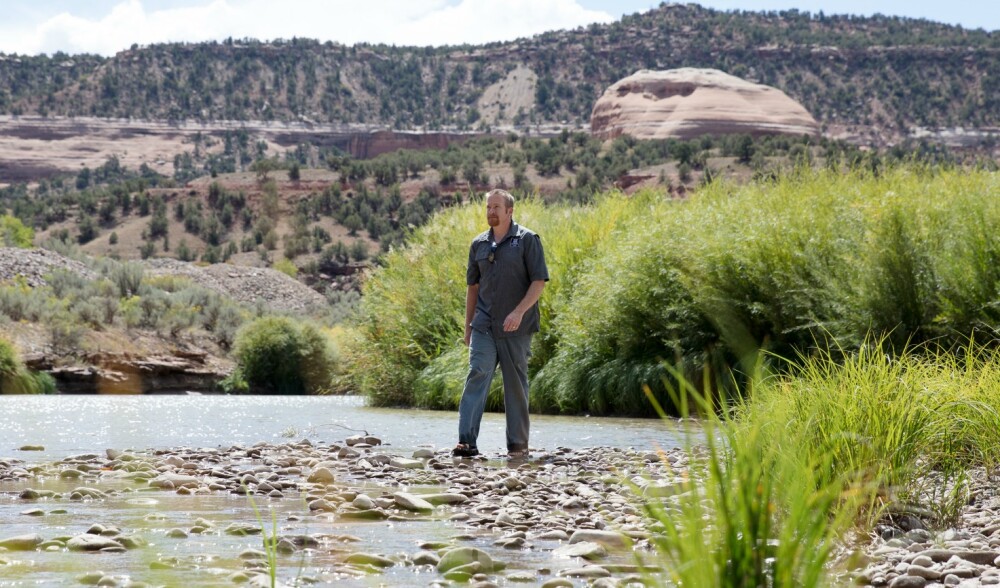In the two decades Mike Wight has been rafting and kayaking the rivers of the American West, he has witnessed an unsightly transformation of the riparian landscapes.
Lush riverbanks once lined with cottonwoods, willows and box elders were overtaken by thickets of tamarisk so dense they blocked all view of the land beyond water’s edge. Sandy beaches where he would once pull in to camp became inaccessible as groves of the woody invasive crowded shorelines.
Rivers dominated by tamarisk, Mike says, become impenetrable.
“Almost every watershed and tributary in the Southwest is infected pretty heavily by tamarisk. There’s a reason why the weeds took over. They’re good at what they do,” he says.
“They have specific advantages that make it hard for native species to compete – things like heavy seed production and deep tap roots that allow them to access water other trees can’t.”
A lifelong outdoorsman who led several raft trips down the Colorado River, Mike has devoted himself over the past nine years to battling tamarisk and another invasive tree, Russian olive, throughout the Colorado River basin.
As river restoration director with the Southwest Conservation Corps, Mike hires and trains work crews tasked with clearing these invasive species from hundreds of miles along major tributaries including the Dolores River, the Verde River, the Gila River and the Escalante River.
The work is critical to the health of the Colorado River basin because tamarisk threatens water supply and has an insidious impact on riparian ecosystems.
Originally imported to the West to help strengthen riverbanks, tamarisk has overrun native species and created monocultures that reduce diversity of plant and animal life. The trees armor riverbanks and channelize rivers, damaging habitat for fish. Recreational and agricultural economies suffer as affected river becomes less accessible for boating and grazing livestock.
“Rivers, especially in the West, are our life blood. The towns and communities we live in all sprung up around that precious resource, water,” Mike says.
He notes that, in Colorado, 2% of the state’s land is riparian or wetland habitat but 80% of all species depend on the “little threads of water and greenery” that rivers provide.
“When rivers are threatened, communities and livelihoods are threatened.”
On the frontlines of the war against tamarisk are platoons of young people armed with chainsaws, wood chippers and chemicals used to remove tamarisk and prevent regrowth so native habitats can rebound.
It’s a grueling job with significant payoff for the environment and communities that supply the workforce.
With support from the Walton Family Foundation and other funders, Mike and Southwest Conservation Corps partners throughout the basin have hired more than 1,500 youth to do the work. Many restoration crew members, typically between 18 and 26 years old, are from underserved populations including Native American tribes and counties with high unemployment.
“We're hiring from local communities and partnering with local contractors to provide economic stimulus in places that need it,” Mike says. This helps build a connection to the river for local communities and promotes teamwork, leadership and grit among members of the young work crews.
Mike has worked most extensively on projects along the Dolores River, which runs 241 miles through western Colorado and into Utah, where it joins the Colorado River.
Over eight years, conservation crews have treated and removed tamarisk from 120 miles of the Dolores and 300 miles overall throughout the Colorado River basin.
“It’s made such a huge impact,” says Mike.
“The most obvious difference is that you can actually see the river. Locals residents thank us because they haven’t been able to see the river in 30 years,” he adds. “We're seeing massive shifts in vegetation cover to native species that are growing and thriving. We're seeing more natural sediment deposition and erosion that wasn't possible when the banks were armored by tamarisk or Russian olive.”
While the gains are significant, Mike says the fight against invasives will require long-term vigilance.
“We're headed in the right trajectory with these rivers. Tamarisk and Russian olive are formidable species, and it takes years of commitment from organizations, private landowners, foundations and land management agencies to complete this restoration effort,” he says. “We're never going to completely eradicate tamarisk and Russian olive, but what we can do is push reset in these river systems.”
Mike recently visited one of his crews, near Gateway, Colo., where an eight-person team was cutting and treating tamarisk starting to regrow along the Dolores River.
A smile stretched across his face as he pointed to a restored stretch of river where native cottonwoods and willows rose against the dramatic backdrop of the canyon’s sandstone cliffs.
“I love being out on the rivers and finding a way to make these beautiful landscapes more healthy and more resilient,” Mike says.
“That’s why I got into this work – to get outdoors, make a difference on the land and make a difference for people.”





